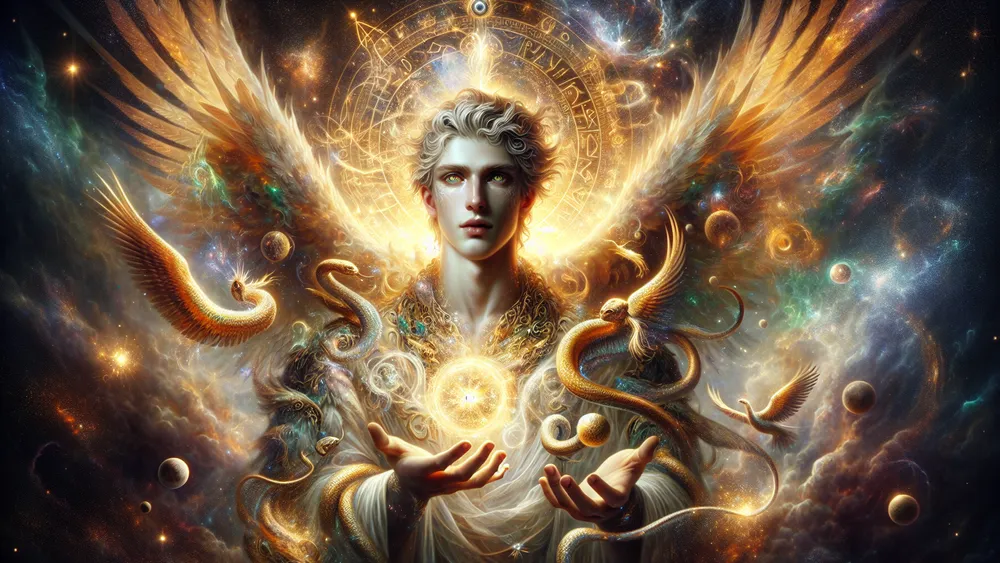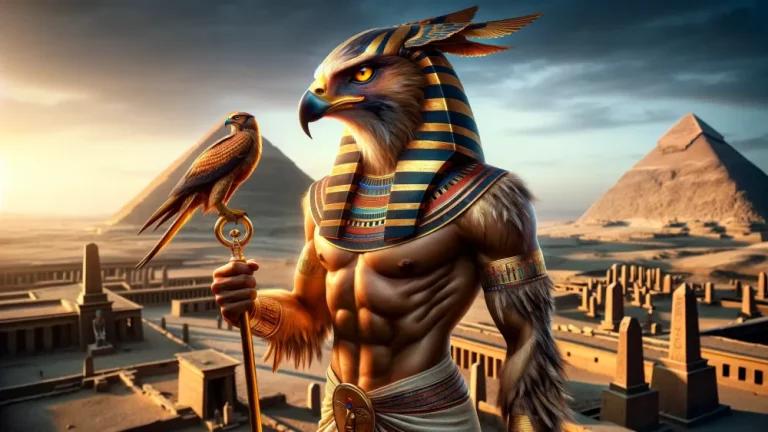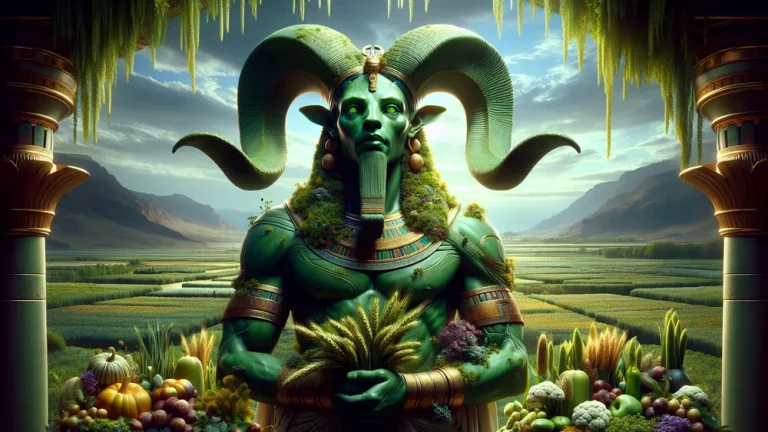Phanes: Primeval Greek God Of Creation And Life In Orphism
Welcome to a look at Phanes, the ancient Greek god who started life and creation in the old religion called Orphism. Think of a seed with all the chance to be a big tree. Like that, Phanes came from the universe egg and brought everything to life.
Key Points:
- Phanes is a prime god in the old Greek belief system called Orphism.
- This god popped out of a cosmic egg, which means the start of life and the universe.
- Phanes began the creation of the world and birth of other gods and goddesses.
- His main signs are the snake, wings, and the cosmic egg.
- He is often compared to other ancient gods like Chaos, Nyx, and Erebus.
- Stories from other cultures, like Egyptian and Norse, have similar figures to Phanes.
- In these tales, the creation of the world often means moving from chaos to order.
In this post, you’ll learn about where Phanes comes from, what he means in old Greek ideas, and how he is described in old stories. We will look into the signs linked to Phanes, such as the snake and gold wings, and their meanings in Greek mythology.
Also, we will check how Phanes made the world and where other gods and goddesses came from because of him. By looking at Phanes and other ancient gods, and seeing parallels in various old tales, you’ll get a deeper sense of big ideas about creation and order.
Whether you’re new to these ancient stories or looking to know more, this complete guide will explain Phanes and his spot among the Greek ancient gods.
Phanes: Overview and Key Facts
| Heading | Details |
|---|---|
| Name | Phanes |
| Role | Ancient Greek god of making everything |
| Origin | Came out of the cosmic egg in Orphism |
| Symbolism | Means the start of life and world |
| Important Signs | Snake, wings, cosmic egg, golden wings |
| Belief System | Orphism |
| Significance | Seen as the first god and the one who made everything |
| Descriptions | With golden wings, he is often described, symbolizing power of gods and ability to go beyond realms |
| Mythological Role | Put order into ancient chaos, also split earth, sky, and sea |
| Related Deities | Nyx (Night), Erebus (Darkness), Gaia (Earth) |
| References | Orphica mentions, a group of old Greek religious writings |
| Comparison | Liked to other ancient gods such as Chaos, Nyx, and Erebus |
| Paralleled Myths | Looks like creator gods in other stories, like Egyptian god Atum and Norse giant Ymir |
Where Phanes Came From
To know the beginning of Phanes, we need to look into the old stories that talk about how he was born and came out of the cosmic egg. These stories tell us more about him. First, we should think about these stories in detail. They tell where he started and what happened. How did he come out of the egg? It’s interesting. Let’s look at them.
How Phanes Was Born
In the myth of Orphism, it is said Phanes came out of the cosmic egg, an ancient thing that held all the possibility for everything. The story says this egg was made in the void of Chaos, the shapeless state before the world was created. This egg, often seen as a bright, golden ball, split open to show Phanes, the first god.
Phanes means “to bring light” or “to appear.” He came out as a bright person with golden wings, meaning the start of everything and making the cosmos bright. It began order and form in the world, as he brought out the pieces of the world and the first gods and goddesses.
The cosmic egg stands for the start of life and the universe in Greek myths. Like a seed or an embryo, it has all the chance for growth and forming inside its shell. This idea isn’t only in Greek stories; many cultures tell creation stories with a cosmic egg. In Greek belief, breaking the egg means moving from chaos to order, from chance to reality. Phanes coming from the egg shows the birth of light and life, setting up the start of the world. Key points about the egg’s meaning include:
- Potential for Creation: The egg has all the parts needed for the world.
- Transition from Chaos to Order: The egg breaking stands for going from shapeless to structure.
- Universal Symbol: Similar stories are in many cultures, showing its wide importance.
By knowing the myth of Phanes’ start and the meaning of the cosmic egg, we see the old Greek view on the start of life and the world’s making.
Phanes emerging from the cosmic egg symbolizes the birth of light and life, transitioning from chaos to order and holding the potential for creating the world, reflecting ancient Greek beliefs on the beginning of existence.
Phanes in Ancient Greek Beliefs
In the religion of Orphism, Phanes has a main and much respected role as the ancient god of creation and life. Orphism, which is different from the more known Olympian religion, focuses on special teachings and mystical parts. Phanes is the creative force that started the universe. He came out of the cosmic egg and is the source of all life and the start of the cosmos.

Like the start of everything, he began the creation of the world and the birth of other gods and goddesses. This makes Phanes very important in Orphism, meaning the start of existence and the arrangement of the ancient chaos. Phanes being the first god and the one who created everything makes him different from other gods in Greek myths.
Not like the gods of Olympus, who rule over certain areas or parts of life, Phanes made everything. Compared to Hesiod’s Theogony, where Chaos is the first state and then gods like Gaia (Earth) and Uranus (Sky) appear, Orphism puts Phanes at the very start. This difference means the special view of Orphism, where Phanes is not just one god among many but the main being from whom all else starts.
Knowing Phanes’ role in Orphism gives us a better understanding of the rich and jumprse beliefs in ancient Greek religion.
Phanes in Old Writings
To better see Phanes’ importance, we can look at how old writings talk about him. By seeing how he is described in ancient texts, we can understand why Phanes matters. Let’s check out the mentions of Phanes in the Orphica and other old writings.
Mentions of Phanes in Orphica
The Orphica, a set of old Greek religious writings, has a lot of info about Phanes and his role in starting everything. These writings are important to Orphism, including hymns, poems, and texts that look into the mysteries of the universe and the divine.
In many of these texts, Phanes is described as the ancient god who came out of the cosmic egg, bringing light and order to the world. The Orphica shows Phanes as a bright person with wings, and his birth starts the creation. These mentions highlight his role as the one who began life and the universe, setting him different from other gods in Greek myths.
Important parts of the Orphica describe Phanes and what he did to create everything. For example, one hymn calls Phanes the “Proto-god,” or first-born, who “came out from the egg, bringing light to the dark void.” Another part says Phanes “unfolded the heavens and separated the earth from the sea,” showing his role in organizing the ancient chaos. These parts not only highlight Phanes’ role in Orphism but also help us understand what he did and how he looked. Key passages from the Orphica include:
- Protogonos Hymn: Describes Phanes as the first-born who brings light to the void.
- Creation Passage: Tells how Phanes separated the heavens, earth, and sea.
- Hymn to Phanes: Praises his bright look and creative power.
Because we look at these passages, we can get a clearer picture of Phanes’ role in old Greek beliefs and his lasting legacy in the Orphica.
Phanes’ Traits and Symbols
To really get Phanes’ role in Greek mythology, we need to look at different traits and symbols of Phanes. Different traits and symbols of him help us understand his role. Let’s dig into the common symbols and what they mean.
Symbols of Phanes
Phanes is linked to several main symbols that capture his role and traits in Greek mythology. A key symbol is the serpent, which you often see coiling around him. In many old cultures, serpents mean rebirth, change, and life’s cycle, which is fitting for Phanes, who stands for the start of everything.
Another main symbol is the cosmic egg from which Phanes came. This egg is a common symbol of potential and creation, like a seed carrying life’s plan. The cosmic egg shows the universe’s origin, meaning that everything came from one start. The wings of Phanes are another important symbol, usually golden and bright.
These wings highlight his divine nature and his power to go beyond the earth. In Greek myths, wings are often linked with gods and other heavenly beings, showing their power to move between worlds. For Phanes, the golden wings show his role as a bright, life-giving force, spreading light and order everywhere.
Think of the wings like a light that cuts through the dark, bringing order to chaos, like a lighthouse guiding ships.
To sum up, here are the main symbols linked to Phanes and what they mean:
- Serpent: Means rebirth, change, and life’s cycle.
- Cosmic Egg: Stands for the universe’s start and potential for creation.
- Golden Wings: Show Phanes’ divine nature and his role in spreading light and order.
Knowing these symbols gives us a better idea of Phanes’ character and his role in Greek myths. Each symbol shows a part of his divine role, giving a full picture of this ancient god.
Phanes and How the World Began
After looking at the symbols linked to Phanes, let’s look at the myths that tell about how he made the universe and organized the original chaos.
Phanes and Making the Universe
In the Orphism story, Phanes has an important role in creating the cosmos. Coming out of the cosmic egg, Phanes brought light into the dark space, starting creation. First, he separated the original parts, like earth from sky and sea. This step of splitting things up is important in many creation stories, meaning bringing order from chaos.

Think of the original chaos as a messy room, with everything all mixed up. Phanes, as someone who organizes, sorts and arranges the parts, making clear areas where life can grow. By setting boundaries between earth, sky, and sea, Phanes prepared the way for life and order. Phanes’ main job in Orphism is making sense of chaos. Before he came, everything was just dark and messy.
Phanes fixed that with his light and creative power, turning the chaotic void into a structured and orderly cosmos. He is like someone turning a block of marble into a sculpture, showing the beauty and order inside. By structuring the original chaos, Phanes not only made the physical world but also set up the basic rules of order and harmony that run it.
This story underlines Phanes as a kind of divine planner, whose creative actions are the base for all existence.
Phanes and the Origins of the Gods
People believe Phanes, the earliest creator, gave birth to many important gods in Greek myths. Among these are Nyx (Night), Erebus (Darkness), and Gaia (Earth). These gods came from Phanes, each showing basic elements of the universe. Nyx, who means night, and Erebus, who represents darkness, speak of the first forces that were there before the world was made.
Gaia, the Earth, is key because she is the base for all life.
Phanes and these gods are like parts of a family tree. From Phanes, many gods came. This connection shows how important Phanes is in the cosmic structure, since his children later played main parts in the myths that followed. Here is a list of the main gods born from Phanes:

- Nyx (Night): Means night.
- Erebus (Darkness): Represents darkness.
- Gaia (Earth): Base for all life and the Earth.
Knowing these ties helps us see the basic role Phanes had in making and organizing the cosmos, letting us understand more about the rich stories of Greek myths.
Understanding Phanes as the earliest creator is crucial as it helps us see the relationships between key gods in Greek mythology and how they form the foundation of the universe.
Comparing Myths
Now that we’ve looked at Phanes’ part in making the world and where the gods came from, we can put him next to other original gods in Greek myths and outside of them.
Phanes and Other First Gods
Phanes, the earliest creator in Orphism, has a special place among the first gods of Greek myths. To get what he does better, it’s useful to put him next to other key figures like Chaos, Nyx, and Erebus. People see Chaos as the very first thing. It stands for the void or gap from which everything else came.
Unlike Phanes, who actively makes and organizes the cosmos, Chaos just exists passively, a formless space before everything else. Nyx, who means night, and Erebus, who represents darkness, both come from Chaos and stand for the early forces before the world had order. While Phanes brings light and order, Nyx and Erebus stand for the dark, mysterious parts of the early cosmos.
To make things clearer, here is a table that breaks down the traits and roles of these gods:
| God | Traits | Roles in Myths |
|---|---|---|
| Phanes | Light, Making, Order | Maker of the cosmos, brings order to chaos |
| Chaos | Void, No shape | Gap from which all things come |
| Nyx | Night, Darkness | Stands for night, early force |
| Erebus | Darkness, Shadow | Stands for darkness, early force |
As you see, each of these gods has a different role in the story. Phanes is unique in actively making and organizing things, bringing light and shape to the universe. On the other hand, Chaos is just the empty space from which everything starts. And Nyx and Erebus show the dark, unknown parts of the early world.
This difference shows what Phanes brings to the Orphism tradition, where he is seen as the divine planner who turns chaos into a neat, orderly cosmos. Understanding these differences helps us see how ancient Greeks thought about the start and shape of the universe.
Phanes in Other Myths
Phanes, an ancient creator god, has interesting similarities with creation figures from other myths. In Egyptian stories, Atum is a god who made himself out of the chaotic waters of Nun to bring out the first parts of the universe. Much like Phanes, Atum deals with the first act of creating and setting up order.
In Norse tales, the giant Ymir is an original being whose body was used to make the world. Ymir’s flesh became the earth, his blood the seas, and his bones the mountains, matching Phanes’ role in organizing everything from a basic state. These examples point out a common theme across cultures: a creator figure who brings structure and life to what was once chaotic or formless.

The general themes about creating and ordering appear in many myths. They show a shared human interest in how the world started and got its shape. In these stories, making the universe often means changing chaos into a place where things can live. For example, Phanes brings light and order to the dark space, while Atum sets up the chaotic waters of Nun, and Ymir’s body is shaped into the world.
These tales, though different in details, underline a similar story of a divine or first figure making order out of chaos, creating a place where life can exist. By looking at these myths, we see how various cultures have tried to understand and explain basic questions about the world and the universe.
The Pantheon of Greek Primordial Deities
Greek mythology’s first gods make up its base, showing the basic parts and forces of the world. These gods, like Chaos, Nyx, Erebus, Gaia, and Phanes, mean things like darkness, night, earth, and making. Every one of these early gods has a key part in the stories, preparing the way for the later gods and goddesses of the Greek world.
For a full look at these old gods, you can check the full list of all Greek Primordial Deities. This list gives detailed info on each god, their traits, and their importance in the rich stories of Greek mythology.
FAQs
1. Who is Phanes in Greek mythology?
Phanes in Greek mythology is the primeval deity of creation and life, emerging from the cosmic egg in Orphism.
2. What is the significance of the cosmic egg in the myth of Phanes?
The significance of the cosmic egg in the myth of Phanes lies in its representation of the origin of the universe and the birth of the first deity, symbolizing creation and potential.
3. How does Phanes differ from other Greek creation deities?
Phanes differs from other Greek creation deities by being the first-born deity who emerged from the cosmic egg and brought order to the primordial chaos in Orphism.
4. What are the main symbols associated with Phanes?
The main symbols associated with Phanes include the serpent, wings, and the cosmic egg.







